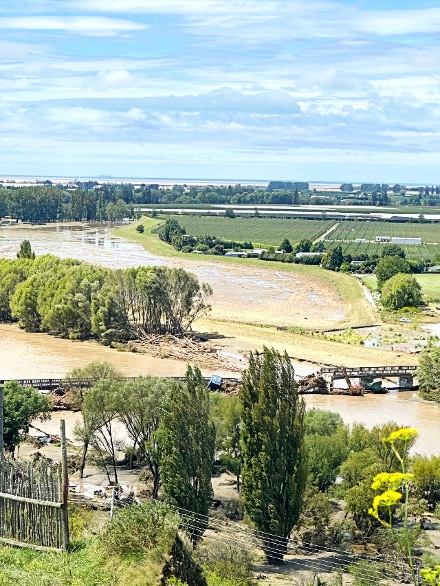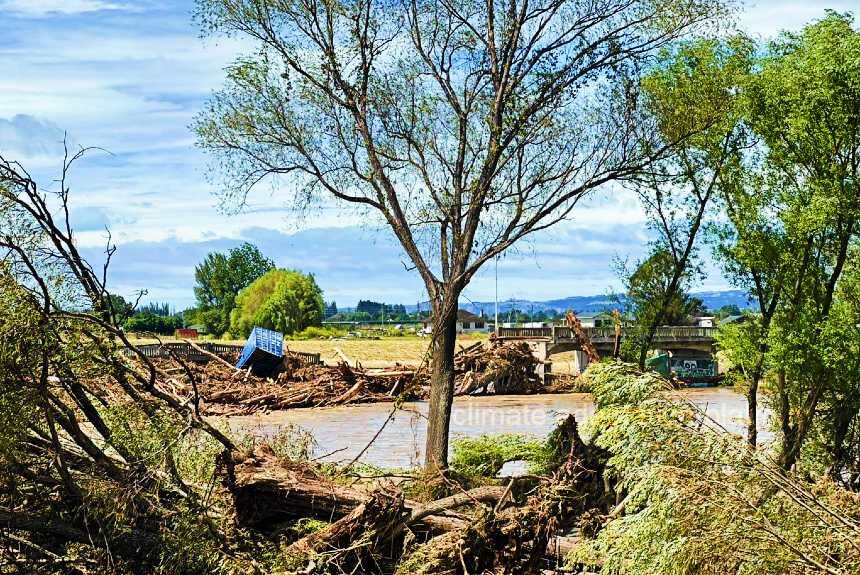A fortnight ago, a record deluge hit New Zealand’s biggest city and surrounding areas, causing widespread floods and landslips.
Then Cyclone Gabrielle came bringing in more devastation, impacting vast parts of the North Island, and triggering the government to declare a National State of Emergency on 14 February. This is the country’s third NSE since the Christchurch earthquake in 2011 and 2020 during the Covid-19 pandemic.
As of writing this blog post, the devastation of Cyclone Gabrielle includes five deaths, with numbers expected to rise as fears that more bodies will be discovered in the coming days.
A quarter of a million people are still without power across the North Island, about 300 people were rescued from their rooftops in Hawkesbay, and around 9000 people have been displaced from their homes, with many – those whose homes were wrecked by floods and landslips remain homeless for some time (Cyclone Gabrielle, 2023).
The Minister for Emergency Management, Kieran McAnulty, signed the State of National Emergency Declaration at 8:43 AM on 14th February (McAnulty, 2023).
McAnulty (2023) explains:
“The local leadership, CDEM groups, and emergency responders in all the affected areas have been doing an outstanding job, but the widespread damage caused by this cyclone means we need a National declaration to support them.
“This declaration will enable the Government to support the affected regions, provide additional resources as they are needed, and help set the priorities across the country for the response.
“A National State of Emergency gives the National Controller legal authority to apply resources across the country in support of a national level response.
“This declaration gives us the ability to coordinate further resources for affected regions. I want to emphasise that the Government has already been surging support and resources to the regions for some days.”
The RNZ article “Cyclone Gabrielle: What the national state of emergency means” mentioned that a national state of emergency means the county can allocate further resources across the county and set priorities in support of a national-level response, and they are reserved for considerable emergencies that passed several legal tests, including an overwhelmed emergency services and the threat of danger to human lives.
The article says that a national state of emergency lasts seven days, just like a local state of emergency, but can be extended as needed.
The declaration applied to six regions has also declared a local state of emergency – Northland, Auckland, Tairāwhiti, Bay of Plenty, Waikato, and Hawke’s Bay – regions most affected by the cyclone (Cyclone Gabrielle, 2023).
McLure (2023) said that Cyclone Gabriel was the worst storm to hit New Zealand this century, with officials describing it as an “unprecedented” natural disaster. Floods rose to envelop homes and buildings in some areas.
Areas around the east coast and far north of the North Island were the worst affected. Coastal communities in Gisborne/Tairāwhiti, parts of Hawke’s Bay, and Northland have been cut off entirely with no power – around 225,000 were without power across the North Island, according to energy minister Megan Woods, and restoration of power could take days up to weeks. Some communities were isolated, with no road access and mobile network service.
In Hawke’s Bay, around 9000 people were displaced, and the height of the floods, some climbed up their roofs for safety. Many houses were also destroyed by floods and landslips, leaving many homeless for some time.
New Zealand’s climate change minister, James Shaw, blames the cyclone’s devastating impacts on climate change. He gave a passionate speech to parliament, expressing regret about the previous ten years of inaction from the government.

Here are some segments of his speech to parliament on 14 February:
“The lost decades that we spent bickering and arguing about whether climate change was real or not, whether it was caused by humans or not, whether it was bad or not, whether we should do something about it or not.”
“There will be people who say it’s ‘too soon’ to talk about these things … but we are standing in it right now. This is a climate change-related event. The severity of it, of course, made worse by the fact that our global temperatures have already increased by 1.1 degrees.”
“We need to stop making excuses for inaction. We cannot put our heads in the sand when the beach is flooding. We must act now”.
New Zealand’s prime minister Chris Hipkins says that in the wake of the extreme events that New Zealand has just experienced, the country must change how and where it builds its communities.
“We need to look at the sustainability of some of the places where we have built previously,” he said. “We’ve got a long history of poor past decisions in New Zealand that we’re confronting right now.”
A warming planet means stronger cyclones and heavier rains
For decades scientists have warned that a warming planet would cause more frequent and intense weather events.
This summer, New Zealand’s North Island has seen exceptionally heavy rains. Met service says that Auckland had received almost half its average rainfall in just 45 days this year (McClure & McLay, 2023).
NIWA climate scientist Sam Dean says that climate change is 10 to 20% responsible for the rain that flooded Auckland and Northland on 27 January, just a fortnight from when Cyclone Gabrielle hit (Wannan, 2023).
As more fossils are burned, it heats the atmosphere and the oceans. Cyclones get their energy from the sea surface; the hotter it gets, the more energy it feeds into the storms, making them stronger.
In an article published in the Advance in Atmospheric Science journal, scientists have found that New Zealand waters, along with the South Pacific and Tasman Sea, sea temperatures have been very warm (Ruru, 2023).
A warming atmosphere also helps fuel storms as hot air holds more moisture creating heavier rainfall.
Relocating people from high-risk areas.
Shaw has spoken to New Zealand’s prime minister and finance minister about the possibility of using insurance payments to rebuild homes in safe areas referring to tens of thousands of New Zealand homes built on flood plains and erosion-pone coastlines (McClure & McLay, 2023).
These are climate adaptation actions that could lead to long-term resilience, but the focus should not shift away from reducing emissions which would be a catastrophic mistake, he adds.
New Zealand’s share of GHG emissions
Johnston (2023) reports that New Zealand is the sixth among OECD when it comes to the amounts of emissions per person. The country stands alongside the US and Australia and even ahead of China, with an average emission of 17 tonnes per year. The country’s gross emissions have also increased by 26% since 1990 (Johnston, 2023).
While New Zealand aims to become net-zero by 2050, it is not on track to meet its target. The country’s current policies come up short of meeting GHG emissions reduction targets needed to achieve net zero by 2050.
For example, current policies will only reduce biogenic emissions by 12% below 2017 levels, which falls short of the 24-47% reduction target (de Jong, 2021).
The agriculture sector accounts for half of the country’s total GHG emissions, but the industry struggles to slash its emissions. The Energy sector at 40% follows, where transport accounts for the bulk of emissions (New Zealand’s Greenhouse Gas, 2022).
Keeping the 1.5°C alive.
To escape the worst consequences of climate change, scientists warn that we would need to keep warming well below 2°C and, if possible, within 1.5°C.
Achieving this will mean that carbon emissions need to fall by 43% by 2030 and 84% by 2050, which UNEP thought is unlikely to happen unless drastic measures are taken.
For the situation to improve, according to the organisation, a “large-scale, rapid” and fossil fuel-free shake-up is needed of our “electricity supply, industry, transport, and buildings sectors, and the food and financial systems.”
Source:
Cyclone Gabrielle live updates: Flooding devastation and fears for those unaccounted for. (2023, February 16). Stuff. Retrieved from https://www.stuff.co.nz/national/weather-news/300808339/cyclone-gabrielle-live-updates-flooding-devastation-and-fears-for-those-unaccounted-for
McAnulty, Kieran. (2023, February 14). State of National Emergency Declared. Beehive.govt.nz. Retrieved from https://www.beehive.govt.nz/release/state-national-emergency-declared
McClure, T. & McLay, C. (2023, February 14). New Zealand minister decries climate crisis ‘lost decades’ in wake of Cyclone Gabrielle. The Guardian. Retrieved from https://www.theguardian.com/world/2023/feb/14/new-zealand-minister-delivers-furious-speech-about-lost-decades-spent-bickering-over-climate-crisis
Ruru, K. (2023, January 11). NZ waters among highest for temperature rises amid record ocean heat, study shows. Stuff. Retrieved from https://www.stuff.co.nz/environment/300782532/nz-waters-among-highest-for-temperature-rises-amid-record-ocean-heat-study-shows
McClure, T. (2023, February 14). Cyclone Gabrielle worst storm to hit New Zealand this century says PM. The Guardian. Retrieved from https://www.theguardian.com/world/2023/feb/13/cyclone-gabrielle-new-zealand-declares-national-state-of-emergency
Johnston, K. (2023, February 14). Does Cyclone Gabrielle have you thinking about climate change? You’re not the only one. Stuff. Retrieved from https://www.stuff.co.nz/environment/climate-news/300805788/does-cyclone-gabrielle-have-you-thinking-about-climate-change-youre-not-the-only-one
de Jong, E. (2021, January 31). New Zealand needs urgent action to cut emissions, says climate change commission. The Guardian. Retrieved from https://www.theguardian.com/world/2021/jan/31/new-zealand-needs-urgent-action-to-cut-emissions-says-climate-change-commission
New Zealand’s Greenhouse Gas Inventory 1990 2020 snapshot. (2022, 12 April). Ministry for the Environment. Retrieved from https://environment.govt.nz/publications/new-zealands-greenhouse-gas-inventory-1990-2020-snapshot
Climate change: No ‘credible pathway’ to 1.5C limit, UNEP warns. (2022, 27 October). United Nations. Retrieved from https://news.un.org/en/story/2022/10/1129912
PHOTO CREDIT: Bridge in Taradale by Courtney Slater. Used with permission.



Leave a Reply